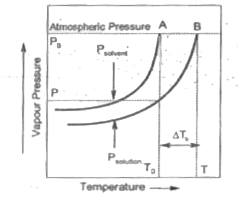A complex containing and is ionized giving the complext is
The correct Answer is:4
To solve the problem, we need to determine the complex containing potassium (K), platinum (Pt) in the +4 oxidation state, and chloride ions (Cl^(-)) that results in 100% ionization with a van 't Hoff factor (i) of 3.
1. Understanding the Van 't Hoff Factor (i):
- The van 't Hoff factor (i) indicates the number of particles the solute dissociates into when it dissolves in a solution. Here, i = 3 means that the complex ionizes to produce a total of 3 ions.
2. Analyzing Possible Complexes:
- We need to consider the possible complexes that can form with K, Pt(IV), and Cl^(-) and check how many ions they produce upon dissociation.
- The complexes we can consider are:
- K2(PtCl4)
- K(PtCl5)
- K(PtCl3)
- K2(PtCl6)
3. Calculating Ionization for Each Complex:
- K2(PtCl4):
- Dissociates into 2 K^+ and 1 (PtCl4)^2- → Total = 3 ions.
- K(PtCl5):
- Dissociates into 1 K^+ and 1 (PtCl5)^- → Total = 2 ions.
- K(PtCl3):
- Dissociates into 1 K^+ and 1 (PtCl3)^2- → Total = 2 ions.
- K2(PtCl6):
- Dissociates into 2 K^+ and 1 (PtCl6)^2- → Total = 3 ions.
4. Determining the Oxidation State of Platinum:
- For the complexes that yield 3 ions (K2(PtCl4) and K2(PtCl6)), we need to check if Pt is in the +4 oxidation state.
- For K2(PtCl4):
- Let the oxidation state of Pt be X.
- The equation is: 2(+1) + X + 4(-1) = 0 → 2 + X - 4 = 0 → X = +2 (not +4).
- For K2(PtCl6):
- The equation is: 2(+1) + X + 6(-1) = 0 → 2 + X - 6 = 0 → X = +4 (correct).
5. Conclusion:
- The complex that meets the criteria of 100% ionization (i = 3) and has platinum in the +4 oxidation state is K2(PtCl6).
Final Answer:
The complex is K2(PtCl6).
- The van 't Hoff factor (i) indicates the number of particles the solute dissociates into when it dissolves in a solution. Here, i = 3 means that the complex ionizes to produce a total of 3 ions.
- We need to consider the possible complexes that can form with K, Pt(IV), and Cl^(-) and check how many ions they produce upon dissociation.
- The complexes we can consider are:
- K2(PtCl4)
- K(PtCl5)
- K(PtCl3)
- K2(PtCl6)
- K2(PtCl4):
- Dissociates into 2 K^+ and 1 (PtCl4)^2- → Total = 3 ions.
- K(PtCl5):
- Dissociates into 1 K^+ and 1 (PtCl5)^- → Total = 2 ions.
- K(PtCl3):
- Dissociates into 1 K^+ and 1 (PtCl3)^2- → Total = 2 ions.
- K2(PtCl6):
- Dissociates into 2 K^+ and 1 (PtCl6)^2- → Total = 3 ions.
- For the complexes that yield 3 ions (K2(PtCl4) and K2(PtCl6)), we need to check if Pt is in the +4 oxidation state.
- For K2(PtCl4):
- Let the oxidation state of Pt be X.
- The equation is: 2(+1) + X + 4(-1) = 0 → 2 + X - 4 = 0 → X = +2 (not +4).
- For K2(PtCl6):
- The equation is: 2(+1) + X + 6(-1) = 0 → 2 + X - 6 = 0 → X = +4 (correct).
- The complex that meets the criteria of 100% ionization (i = 3) and has platinum in the +4 oxidation state is K2(PtCl6).
The complex is K2(PtCl6).
Topper's Solved these Questions
Similar Questions
A complex containing K+,Pt(IV) and Cl−− is 100% ionised giving i=3. Thus, complex is:
View SolutionA 0.001 molal solution of a complex represented as Pt(NH3)4Cl4 in water had freezing point depression of 0.0054∘C. Given Kf for H2O=1.86Km−1. Assuming 100% ionization of the complex, write the ionization nature and formula or complex.
View Solution
Knowledge Check
- Question 1 - Select One
The name of the complex [Pt(NH3)6]Cl4 is
Ahexaammineplatinum (IV) chlorideBhexaammineplatinum (II) chlorideCtetrachlorohexaammineplatinum (IV)Dtetrachlorohexaammineplatinum (II).
A complex of iron and cyanide ions is 100%ionised ar 1m (molal). If its elevation in b.p.is 2.08 then the complex is (Kb=0.52∘mol−1kg),
View SolutionConsider following figure and answer the questions at the end of it. Figure explains elevation in boiling point when a non-volatile solute is added to a solvent.

Variation of vapour pressure with temperature and showing elevation in boiling point.
A complex of iron and cyanide ions is 100% ionized at 1m (molal). If elevation in boiling point is 2.08∘(Kb=0.52∘mol−1kg) then the complex is:View SolutionAn aqueous solution of a solute AB has b.p. of 101.08∘C(AB is 100% ionised at boiling point of the solution ) and freezes at −1.80∘C. Hence, AB(Kb/Kf=0.3)
View SolutionAn 1% solution of KCI(I),NaCI(II),BaCI2(III) and urea (IV), have their osmotic pressure at the same temperature in the ascending order (molar masses of NaCI,KCI,BaCI2 and urea are respectively 58.5,74.5,208.4,60gmol−1 Assume 100% ionization of the electrolytes at this temperature
View SolutionA hexa-coordinated complex of formula CoCl3.6H2O undergoes 100% ioisation is aqueous solutin to give van't Hoff factor equal to 3. Which of the following is/are correct regarding the given complex?
View SolutionThe 0.0001 molal solution of a complex AB10 has the freezing point of −0.0015∘C in water. Assuming 100% dissociation of the complex, find the proper representation of the complex [Kf(H2O=1.86Km−1)]
(a) [AB8]
(b) [AB3]B7
(c )[AB7]B3
(d) [AB5]B5 .View SolutionIn solution, the complex, [Pt(NH3)6]Cl4 gives
View Solution
